World Jamborees
Federation of Irish Scout Associations
Co-Cumann Gasóga Éireann
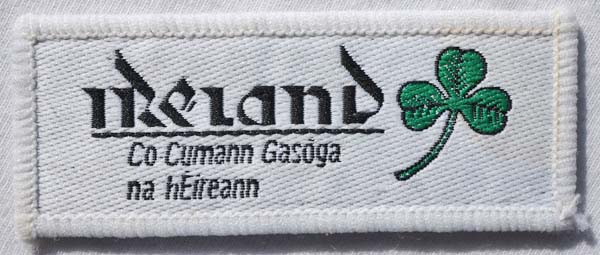 | The Federation of Irish Scout Associations was formed in 1965 to allow both C.B.S.I. and S.A.I. to be recognised by the World Organisation of the Scout Movement. |
| The badge would be normally worn on the uniform at international jamborees where a mixed group of C.B.S.I. and S.A.I. attended. Badge measures 70mm by 30mm. | 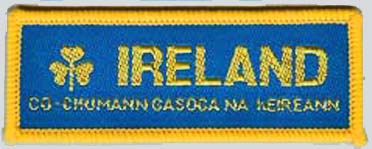 |
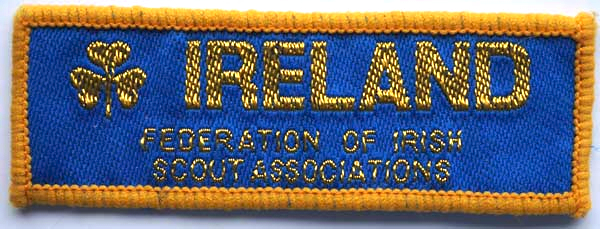 | The badge was produced in English and Irish |
1st World Jamboree Olympia London 1920 |
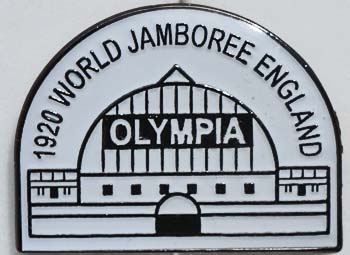
The first World Scout Jamboree took place The Olympia, London, England, from the 30th of July to the 8th of August. There was a strong representation of Scouts from Ireland. The Theme of the Jamboree was Develop World Peace. The Dublin Boy Scouts arrived in London on the 30th of July and were headquartered at the Y.M.C.A. at Addington.
In the Arena a large display depicting a mountainous area at one end a jungle and a large old wooden wall at the other. The Irish Scouts put on a depiction of the story of the Red Hand of Ulster and an episode from the Life of Saint Patrick depicting the story of Easter Eve A.D. 433 when Saint Patrick converted King Laoghaire. The Irish Scouts also depicted the story of Irish Linen and erected tents to Irish pipe music.
The Irish Scouts was made up of Scouts from the 11th City (Abbey Street), Harold’s Cross and Chapelizod. As Scouts from the Host nation they showed Scouts from Switzerland and France around the sights of London, the Reverend Mr. Smyth and Mr. Hare acting as interpreters.
Lord Holmpatrick and District Scout Master Keown were in charge of the Belfast Scouts.
Empire or Imperial Jamboree Wembley 1924 |
The Imperial or Empire Jamboree was held at Wembley, the Jamboree opened on Friday the 1st of August and finished on the 8th of August. 351 Free State and 400 Ulster Scouts attended. The Irish Free State was represented by Scout and Rover Troops from Dublin and Wicklow under the leadership of Assistant District Commissioned Preston and G.S. Childs. The Irish contingent camped at Webley Paddocks. As well as displays of Irish Dancing there were also Hurling matches between the Dublin and Wicklow Scouts. The Irish Contingent, including Scouts from Ulster, attended a wreath laying ceremony at the Cenotaph on the Tuesday, the wreath, brought over from Ireland by the Free State contingent, was laid by the Free State chief Scout the Earl of Meath.
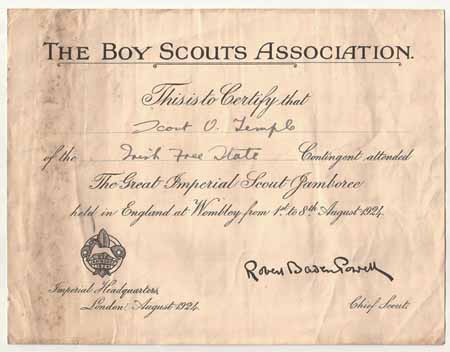
| Each Scout that attended the Jamboree received a certificate. The certificate appears to be signed by Baden-Powell but as 12,500 Scouts are reported to have attended the Jamboree I kind of doubt if he signed them all personally. | 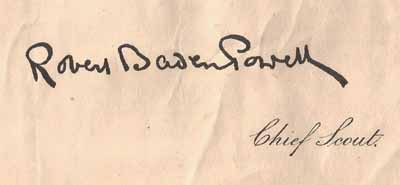 |
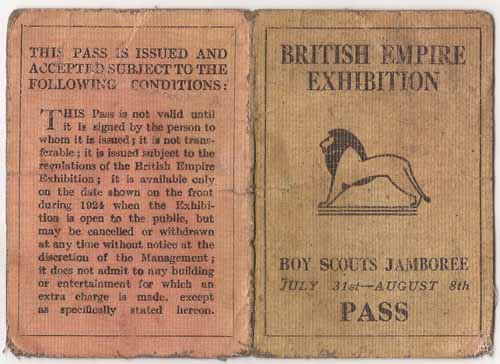 | 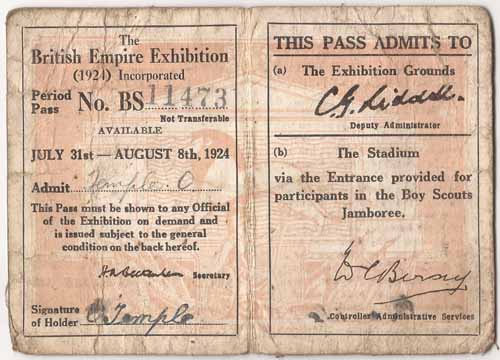 |
The British Empire Exhibition was in progress while the Jamboree was taking place, each Scout was issued with a pass.
2nd World Scout Jamboree Ermelunden Denmark 1924 |
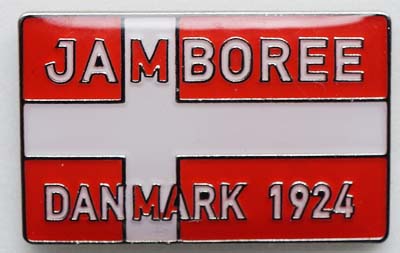
The 2nd World Scout Jamboree took place from the 10th of August to the 17th of August 1924. 14 Scouts and 2 Scout Leaders from the Irish Free State who had attended the Jamboree in London travelled on to Denmark to attend the 2nd World Scout Jamboree. The World’s Scoutcraft Championships were held at the Jamboree, the Scout contingent from the United States won scoring 181 points, Great Britain were second with 172 points.
3rd World Scout Jamboree Birkenhead, England 1929. |
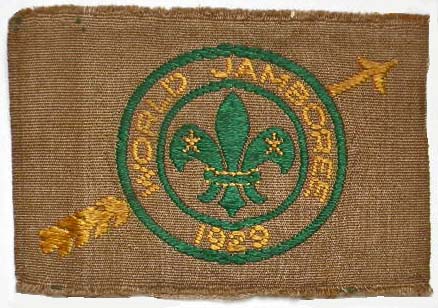
The 3rd World Jamboree took place at Arrowe Park, Birkenhead, England, from the 31st of July to the 13th of August. 525 Scouts from the Irish Free State attended the Jamboree. The Irish contingent was under the command of Viscount Powerscourt, K.P., Provincial Commissioner assisted by District Commissioner Lord Holmpatrick, D.S.O. and the Hon. Claud Brabazon O.B.E.
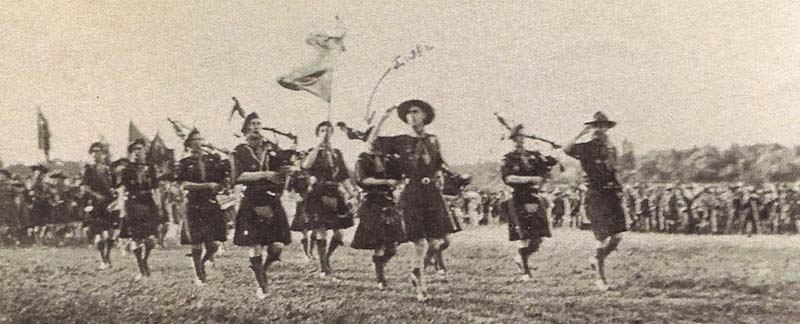
The Irish Free State Contingent march past the Regent and Baden-Powell. (Photo: Victor Edmonds)
Over 100 boys from the Irish contingent took part in the pageant at the Jamboree, they depicted an incident from the life of Fionn McCool and were dressed in costume of the period. The County Wicklow Scouts Pipe band, dressed in their dark green kilts, played in the march of the nations.
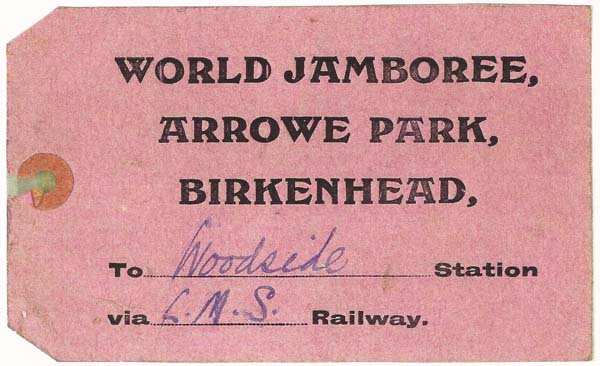 | 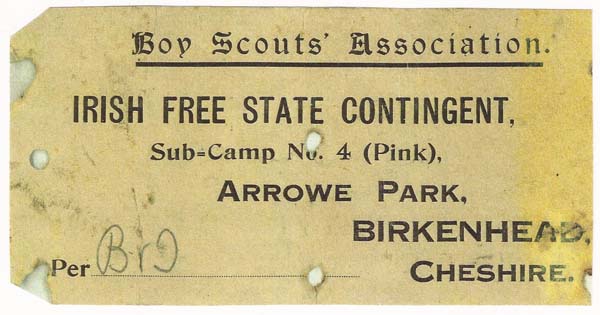 |
Luggage labels from the Irish contingent the second showing they were in Sub-camp number 4 (Pink). (Photos: Victor Edmonds)
4th World Scout Jamboree Gödöllő Hungary 1933 |
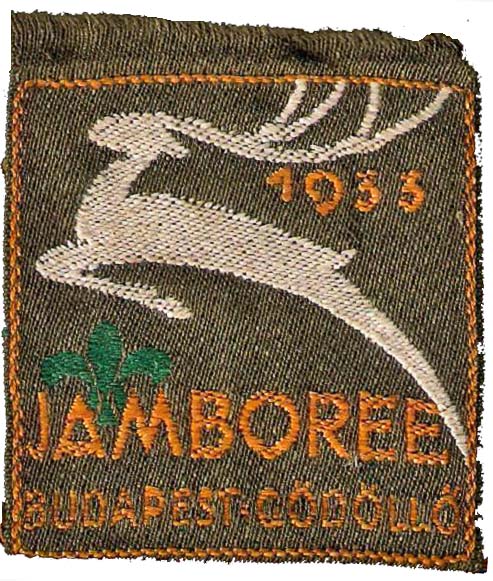
The 4th World Scout Jamboree took place in Gödöllő Hungary from the 2nd of August to the 15th of August 1933. 70 Scouts from the Irish Free State set sail from the North Wall in Dublin to Liverpool on the first leg of the journey to Hungary. After travelling through England they arrived in Ostend late on Sunday night travelling on by train to Malines where they picked up the Belgian contingent. The journey across Europe was an interesting one, arriving in Cologne early Monday morning they were greeted by a wonderful warm reception from the local Nazi Youth Movement who treated the Irish and Belgian Scouts to a most welcome breakfast. The next stop was at Wurzburg an historic old town with a particular interest to the Irish Scouts as this town was one of the centres of early Irish missionaries, Saint Killian being buried in one of the principle towns. The whole of Wurzburg turned out to greet the Scouts and hundreds of Nazi Youth, including many girls in uniform, lined the platform greeting the train with the Nazi salute and playing their National Anthem. While waiting for lunch the Scouts quickly made friends with the Germans and by the time the train departed most of the Nazi Youth were wearing Scout badges while the Irish Scouts were arrayed with Nazi armlets and cap badges and were expert in the Nazi salute.
Approaching the Austrian border all the Nazi badges were removed and as the train travelled across Austria they received a welcome where ever they went. Arriving at their destination at 2am the Scouts were awoken by the local band playing a rousing tune while most of the town appeared on the platform to greet them.
Arriving at the campsite the Irish Scouts were happy to see their pitch was among the trees, shade would be welcome during the hot days to come. The Irish Scouts were pitched next to Scouts from Scotland close by were Malta, Gibraltar and Wales. It was during the Hungarian Jamboree the Irish Scouts discovered the need for a National Badge, after too many occasions when they were mistaken for Scottish or English Scouts a trip to the local village where all available Green, White and Orange ribbon was purchased and Tri-Colour badges quickly stitched together and worn on the right breast of their uniform.
Mr. G Childs Commissioner of the Irish Free State Scouts presented Baden-Powell with a Claddagh Ring at the Jamboree.
| 2 Irish Scouts in Budapest during the Jamboree. On the left in the photo is Jimmy Heaney who wrote a Log Book on the Jamboree. (Photo: Victor Edmonds) | 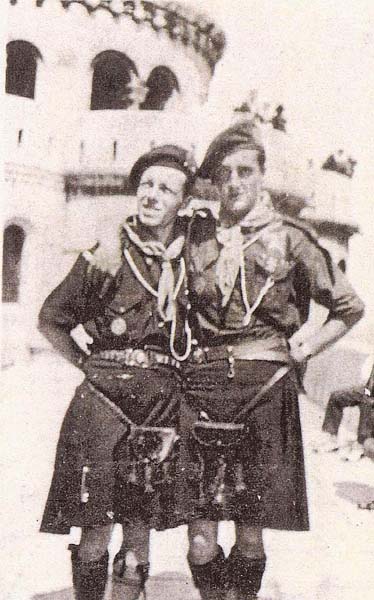 |
| A luggage label issued to the Irish contingent showing details of their journey via B&I S.P. Co. Liverpool, L.M.S. Railway Crewe Dover, Ostend & red train. (Photo: Victor Edmonds) | 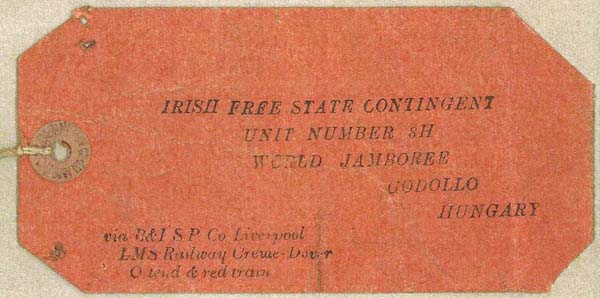 |
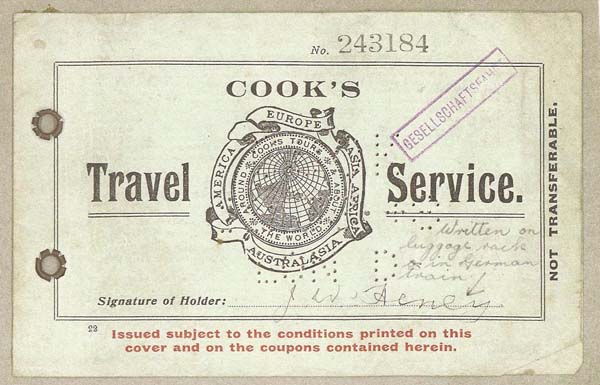 | A luggage label issued to the Irish contingent and used during the journey through Germany. (Photo: Victor Edmonds) |
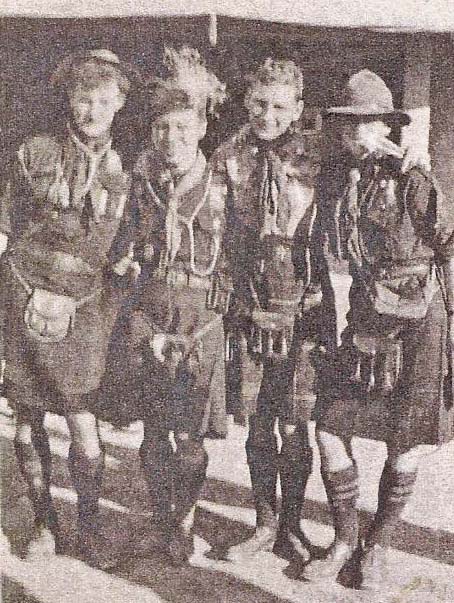 Irish and Scottish Scouts (Photo: Victor Edmonds) | 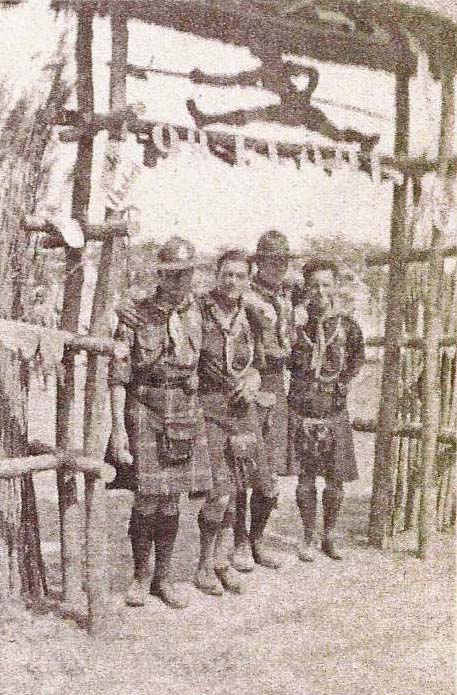 Irish and Scottish Scouts (Photo: Victor Edmonds) |
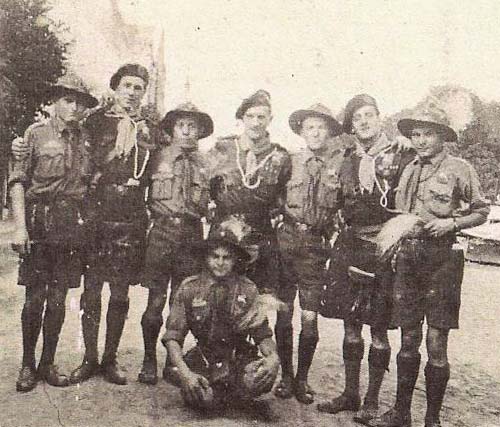 Irish and Hungarian Scouts (Photo: Victor Edmonds) | 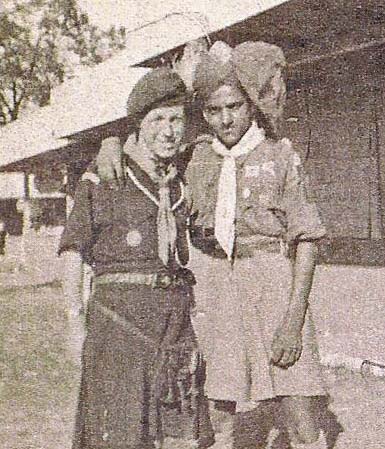 Irish and India Scouts (Photo: Victor Edmonds) |
5th World Scout Jamboree Netherlands 1937 |
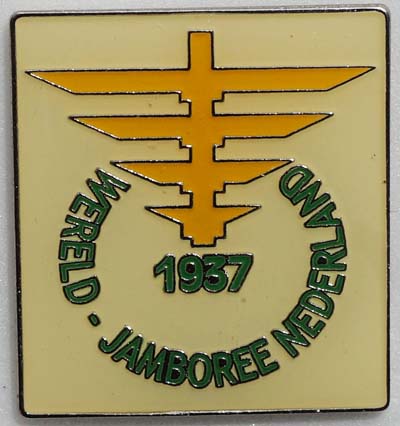
The Jamboree was held at Vogelenzang, Bloemendaal in the Netherlands, the Jamboree was opened by Queen Wilhelmina of the Netherlands on the 31 of August 1937 and closed on the 9th of August when Baden-Powell retired from an active role in the Scout movement. The Irish Free State contingent at the Jamboree was made up of 63 Scouts and leaders. The Free State contingent departed Dublin’s North Wall by the B and I boat to Liverpool. Before departure the Scouts paraded in front of a large crowd and were presented with the Irish tri-colour which will lead the Scouts in the march past of Nations at the Jamboree, the tri-colour was presented to the Scouts by Lord Mayor of Dublin Alderman Byrne T.D. The Scouts also brought a Carrickmacross Lace luncheon set which they presented to H.R.H. Princess Juliana, Patroness of the Scouts in Holland.
District Commissioner G. S. Childs was in charge of the Irish contingent District Scoutmaster F. M. J. Kerr was second in command with District Cub-master H. V. Miller acting as medical officer, two Graystones Scout pipers, Arthur Andrews and Noel Ferns., also accompanied the contingent. The Irish contingent also had Scouts from Skibbereen and Bandon County Cork.
127 Scouters from Northern Ireland attended the Jamboree. On their journey to Holland they stopped off in London where they were shown around the Houses of Parliament by Sir Joseph McConnell and Lord Castlereagh.
3rd World Rover Scout Moot Scotland 1939 |
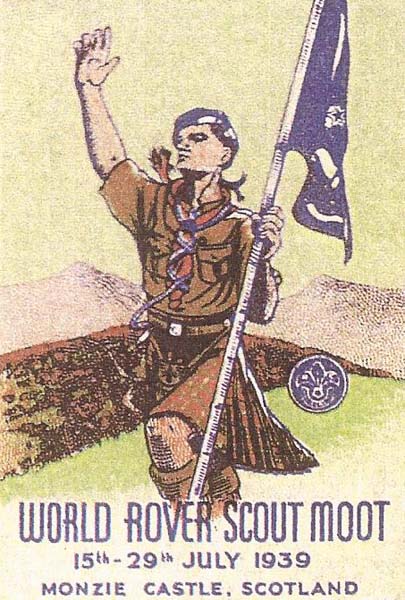
The World Rover Scout Moot took place at Monzie Castle Scotland from the 15th to the 29th of July 1939. Over 3500 Rover Scouts from 48 different countries attended the Moot. 24 Irish Rover Scouts attened the Jamboree.
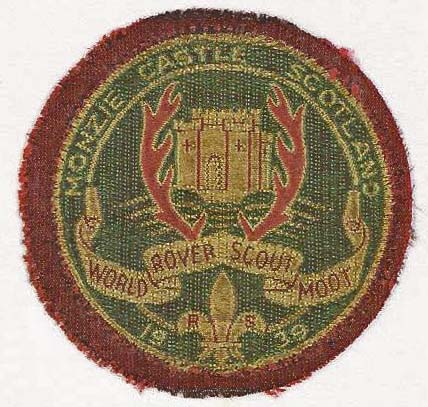 | The World Rover Scout Moot cloth patch worn by all participants at the Moot. (Photo: Victor Edmonds) |
| Crew BII. Irish Rover Scouts with Rover Scouts from England and Liechtenstein includes members of the Graystones band. (Photo: Victor Edmonds) | 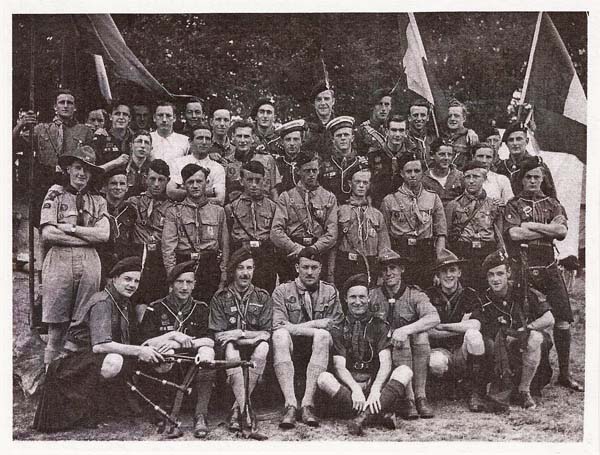 |
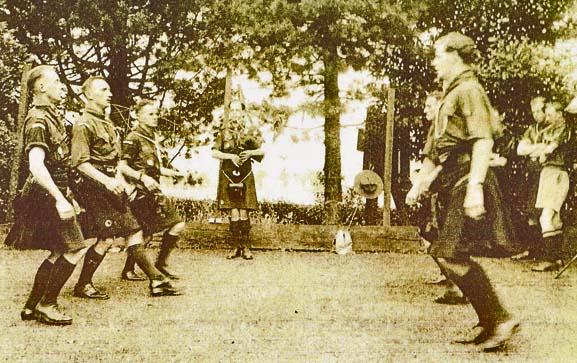 | Rover Scouts from the Graystones band dance an Irish Reel at Kingarth Hotel in Crieff during a party given by the Irish Contingent for their friends at the Rover Moot. (Photo: Victor Edmonds) |
6th World Scout Jamboree France 1947 |
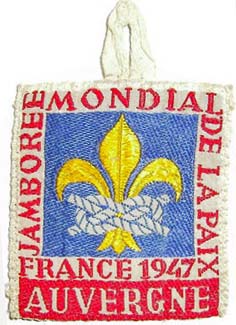
Held in in the forest at Moisson, 50 miles from Paris, it was the first Jamboree held since the death of Baden-Powell in 1941. The Jamboree opened on the 9th of August and closed on the 20th of August. Ireland, which had been known as The Irish Free State, was now Eire so the Scouts from Ireland attending the Jamboree were known as the Eire Contingent. The Eire Contingent for the 6th World Jamboree numbered 35 and 105 Scouters from Northern Ireland.
The 35 Irish Scouts suffered a rough crossing of the English Channel arriving at the Jamboree site on Friday morning, after erecting their tents most of the day was spent recovering from the journey. On the Saturday 500 Scouts representing all of the nations attending the Jamboree visited the Arc de Triomphe for a wreath laying ceremony. 7 Scouts from the Eire Contingent and ten from Northern Ireland attended. The Irish Tri-Colour was carried by Billy Martindale and the Northern Ireland flag by Jim Parker of Belfast. The Irish Scouts camped in Auvergne sub-camp with Scout Troops from Norfolk, Surrey and Worcestershire U.K. William Fleming-Thompson was the leader of the Irish Contingent, he was Commissioner for Oriel District and was a headmaster at Drogheda Grammer School.
7th World Scout Jamboree 1951 |
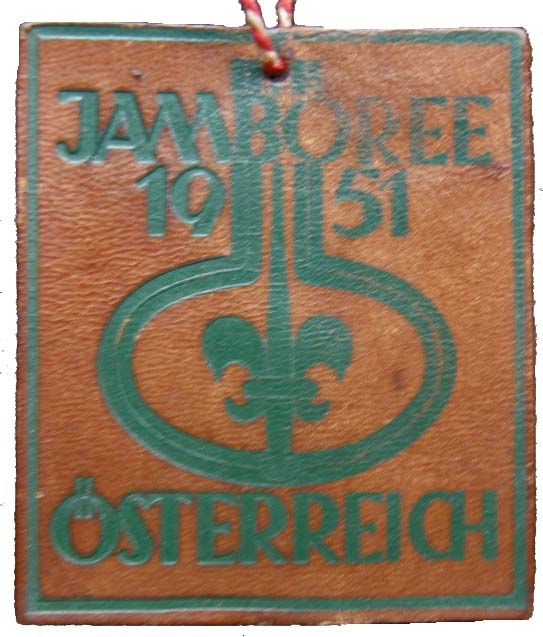
The 7th World Scout Jamboree was held in the American Sector Bad Ischl & Salzkammergut, Austria from the 3rd to the 13th of August. 59 Irish Scouters attended the Jamboree. Scouts from the S.A.I. and C.B.S.I. attended under the newly formed Oganaigh Fódla (Fódlach) which translates as National Youth or Juveniles of the Nation. 9 Scouters left from Dublin while the other 50 departed from Cork. The group that departed from Cork had the unusual experience of camping in five different countries over five nights, on Wednesday they camped in Listowel, Thursday in England, Friday in France, Saturday in Switzerland arriving at the Jamboree on Sunday where they spent their first night on Austrian soil. The Irish contingent which was led by the 5th Dublin also included Scouters from the 1st Duagh (a small village in County Kerry) Scout Troop and the Tuam Scout Pipe Band. In Switzerland member of the Listowel Scout Troop met up with their old friend Helmut Welss from Heidelberg Germany, Helmut was a member of the Scout Troop for a number of years following his evacuation to Ireland at the end of WW2. The Listowel Scouts also met with the Listowel Scout Troop from Ontario Canada at the Jamboree.
At the Jamboree Irish Scouts took part in a radio broadcast for the Dutch radio station Hilversum Radio, the broadcast was used in the closing part of a special Jamboree broadcast which was broadcast worldwide. The entrance gate to the Irish camp site, designed by the Dean of Cashel, as authority on Celtic design, attracted considerable attention and was reproduced by a local postcard company copies of which were available at the Jamboree.
8th World Scout Jamboree Canada 1955 |
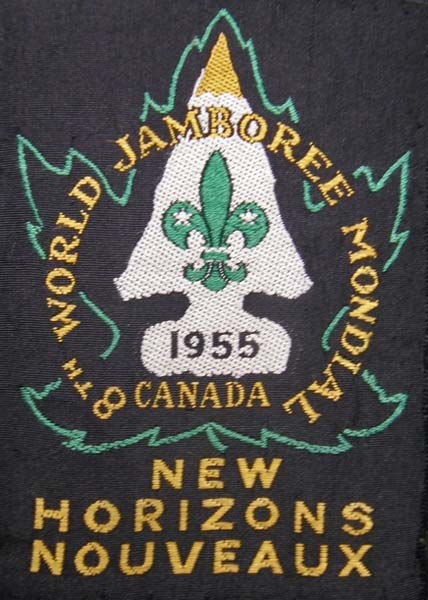
9th World Scout Jamboree England |
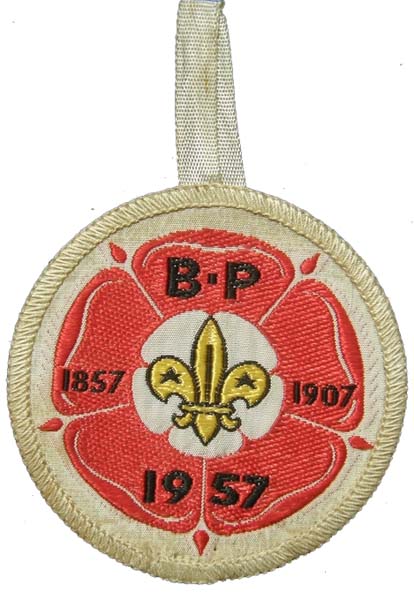
The 9th World Scout Jamboree was held at Sutton Park, Sutton Coalfield, Warwickshire, England from the 1st of August to the 12th of August 1957. 490 Irish Scouters attended. Troops from Dublin, Cork, Limerick, Donegal and Waterford were represented at the Jamboree. The Irish Scouts preformed in front of a crowd of 35,000 in the Grand Arena, their performance included a Crock of Gold that could turn an unruly boy into a Scout, miming the ten Scout Laws, the Irish Scout Yell and a selection of Irish songs. The Irish contingent also performed a display of Irish dancing in the camp theatre. The Scouts also did their bit for Irish tourism, the Irish headquarters and five sub-camps displayed Board Failte posters and travel brochures were handed out to all visitors.
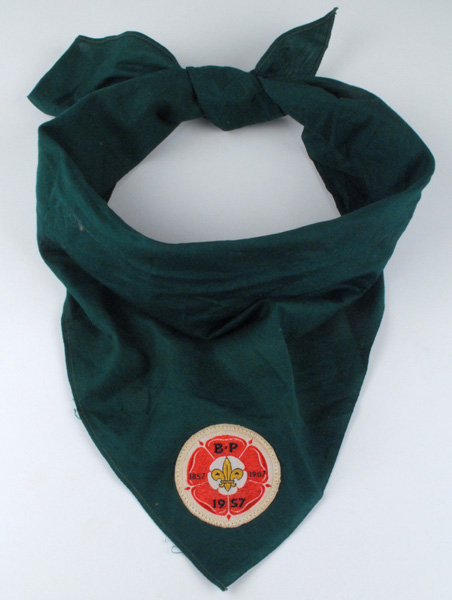 | The Irish contingent wore a green scarf/Necker with the Jamboree badge at the point. |
10th World Scout Jamboree Philippines 1959 |
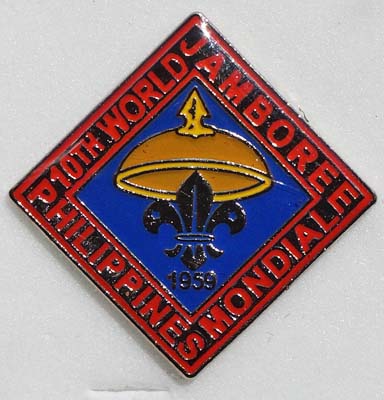
The 10th World Scout Jamboree took place at Makiling Los Baños, Laguna, in the Philippines from the 17th of July to the 26th of July 1959. 2 Scouters represented Ireland at the Jamboree, they were Michael Webb Patrol Leader in the 20th (Dundrum) Troop and Jim McKee Skipper of the 19th (Glasnevin) Troop. Both Irish Scouters reported swapping was a popular pastime at the Jamboree where not only badges were traded but several small exotic lizards were on offer and both Scouters did well to hold onto their green uniform kilts which were in great demand, 100 US dollars being offered for one.
11th World Scout Jamboree 1963 |
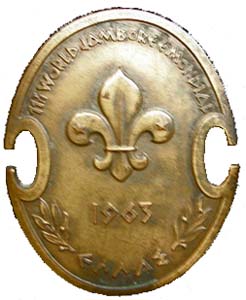
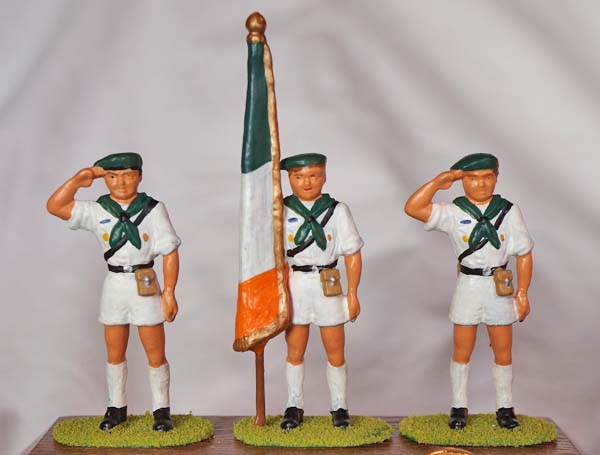
A new semi-tropical uniform had been designed for the Jamboree, white shirt, shorts and socks.
12th World Scout Jamboree U.S.A. 1967 |
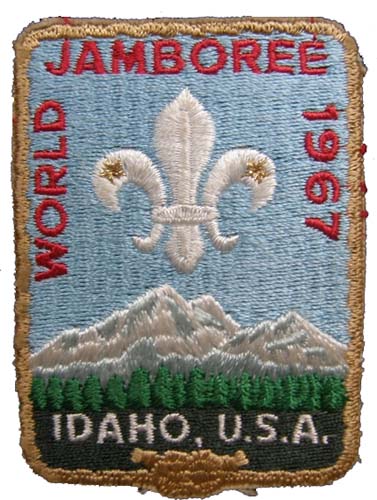
The 12th World Scout Jamboree took place in Farragut State Park, Idaho, U.S.A. The Jamboree started on the 1st of August and finished on the 9th of August. 28 Scouters from the Scout Association of Ireland and 27 Scouters from the Catholic Boy Scouts of Ireland attended. This was the first Jamboree the C.B.S.I. attended as C.B.S.I. Scouters. The S.A.I. Scouts were led by Mr Fraser Pelley and the C.B.S.I. by Brian Lahiffe. The Irish Scouters flew from Shannon Airport on the 28th of July, the B.O.A.C. flight which called at Shannon to collect the Irish Scouters already had on board a contingent of 82 U.K. Scouters.
13th World Scout Jamboree Japan 1971 |
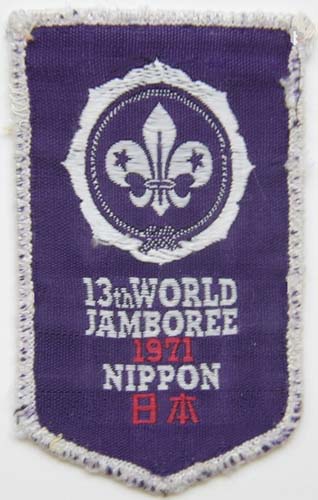
The 13th World Scout Jamboree took place in Fujinomiya Shizuoka Japan from the 2nd to the 10th of August 1971. 5 Scouters from the Federation of Irish Scout Associations attended the Jamboree, Mr Stephen Spain, leader. Mr J. Fay, deputy leader and Scouts John Craigie, Michael Norman and Raymond Wilkinson. The five Scouters spent a week holidaying in Japan after the Jamboree.
14th World Scout Jamboree Norway 1975 |
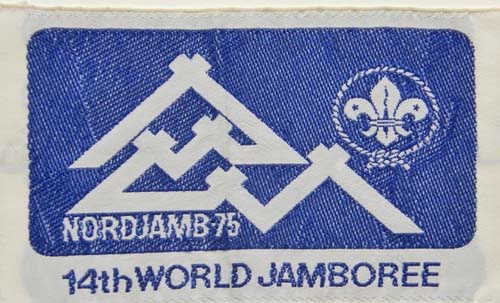
The 14th Jamboree was held in Lillehammer Norway and was Co-hosted by Norway, Denmark, Finland, Iceland and Sweden. The Jamboree started on the 29th of July and finished on the 5th of August. 250 Irish Scouters attended the Jamboree and among the many activities they took part in were a two-day hike, an Irish Scout joined seven other Scouts from different countries to spend two days exploring the Norwegian mountains, the Norwegian Army supplied 2,000 soldiers who monitored the 700 Patrols with helicopters and ambulances in constant radio contact with the control center at Jamboree headquarters. Scouters from the Catholic Boy Scouts of Ireland and the Scout Association of Ireland attended under the auspices of the Federation of Irish Scout Associations.96 large red balloons, one for each country represented at the Jamboree, were released at the opening ceremony, the finder of the Irish balloon got to have tea with the Irish Scouts. The Jamboree was divided into ten Sub-Camps, each with its own administration, bank, shop and post office.
After the 10 day Jamboree the Irish Scouts spent four days as guests in the homes of Swedish and Norwegian Scout and Guide Families.
15th World Scout Jamboree Canada 1983 |
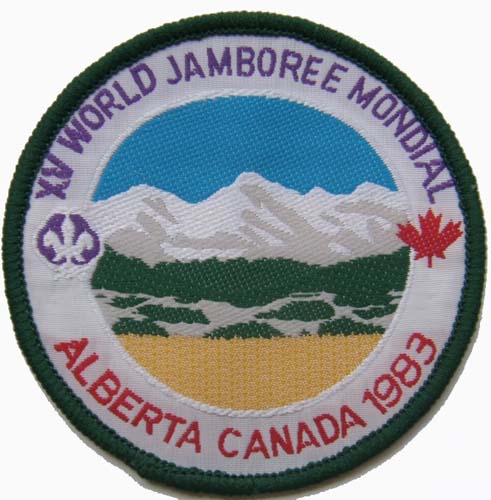
The 15th Jamboree was held in Kananaskis County, Alberta, Canada from the 5th of July to the 15th of July. 86 Irish Scouters attended the Jamboree. The Irish Scouters flew from Dublin to Boston were they were guests of the Boston Scout Council for three days before travelling on to Canada to attend the Jamboree. The Irish contingent was made up of Scouters from the Scout Association of Ireland and the Catholic Scouts of Ireland. Girls were admitted to the C.B.S.I. I Venture Scouts in 1983 and the Boy was dropped from the name.
16th World Jamboree 1987 – 1988 |
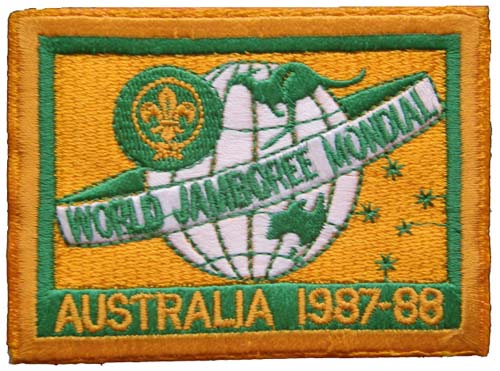
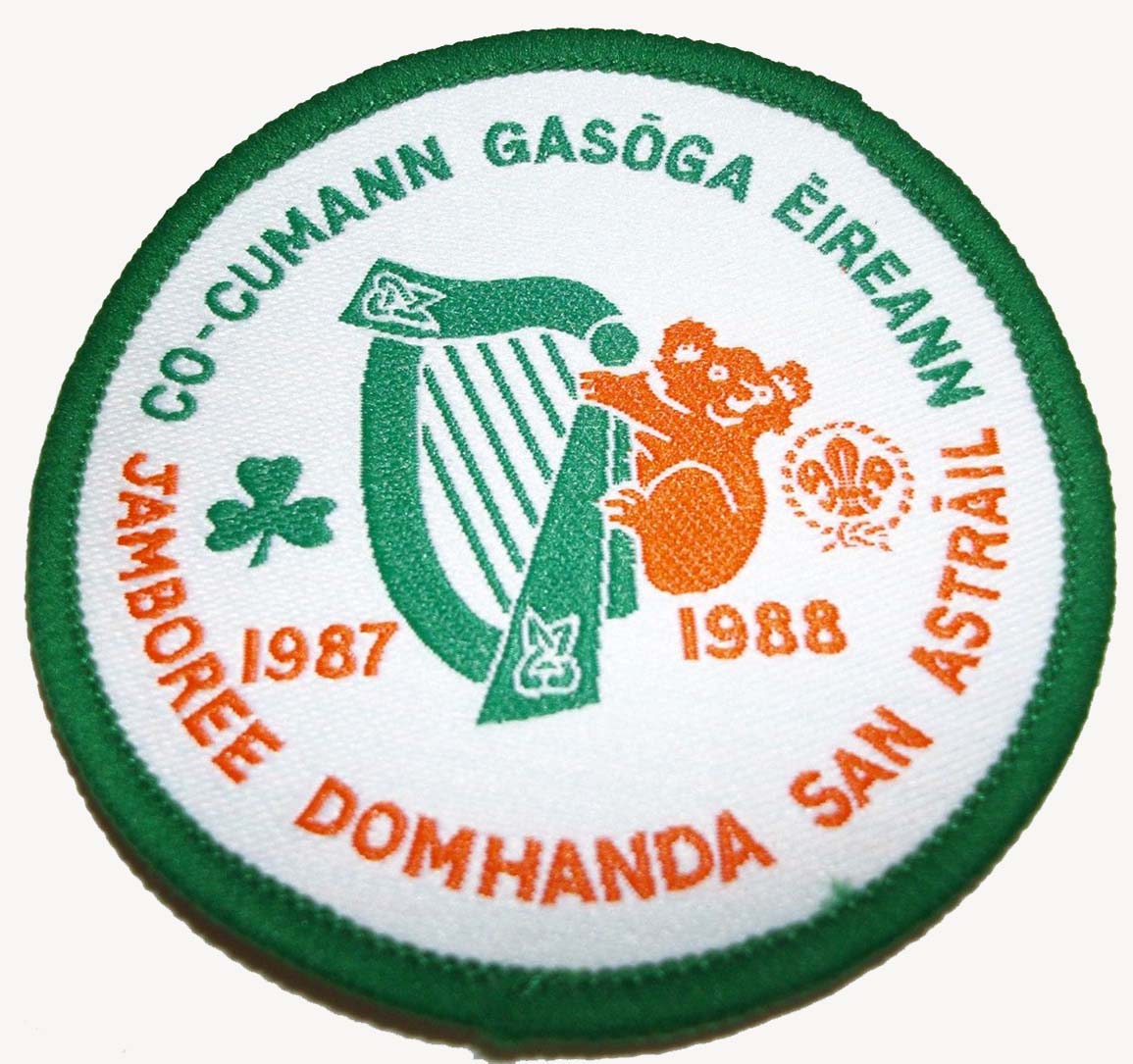 | Co-Cumann Gasóga Éireann = Federation of Irish Scout Associations Jamboree Domhanda San Astráil = World Jamboree In Australia |
18th World Jamboree Netherlands 1995 |
| Northern Ireland Contingent Held on a Polder near Dronten, Flevoland, Netherlands from the 1st to the 11th of August, overall attendance about 30,000 from 166 countries and territories. | 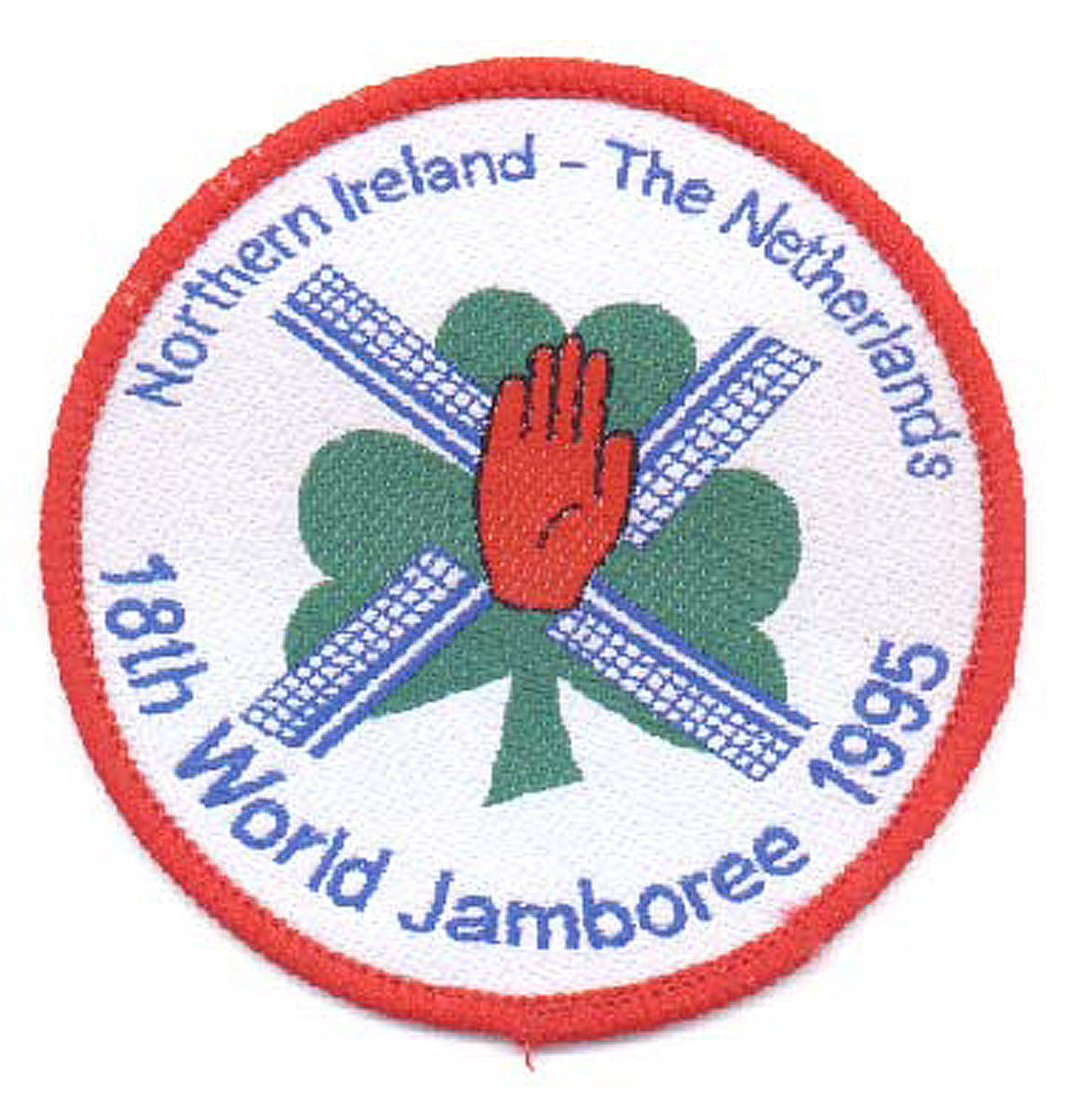 |
19th World Jamboree Chile 1999 |
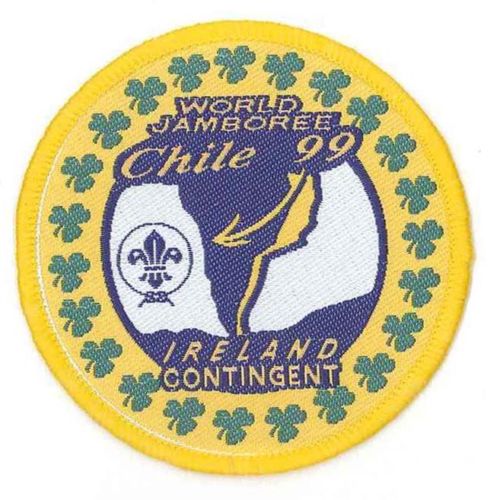
The first World Jamboree to take place in South America. Attended by 31,000 Scout form the 27th of December to the 6th of January. Around 65 Scouters from Ireland attended this Jamboree.
20th World Jamboree Thailand 2003 - 2004 |
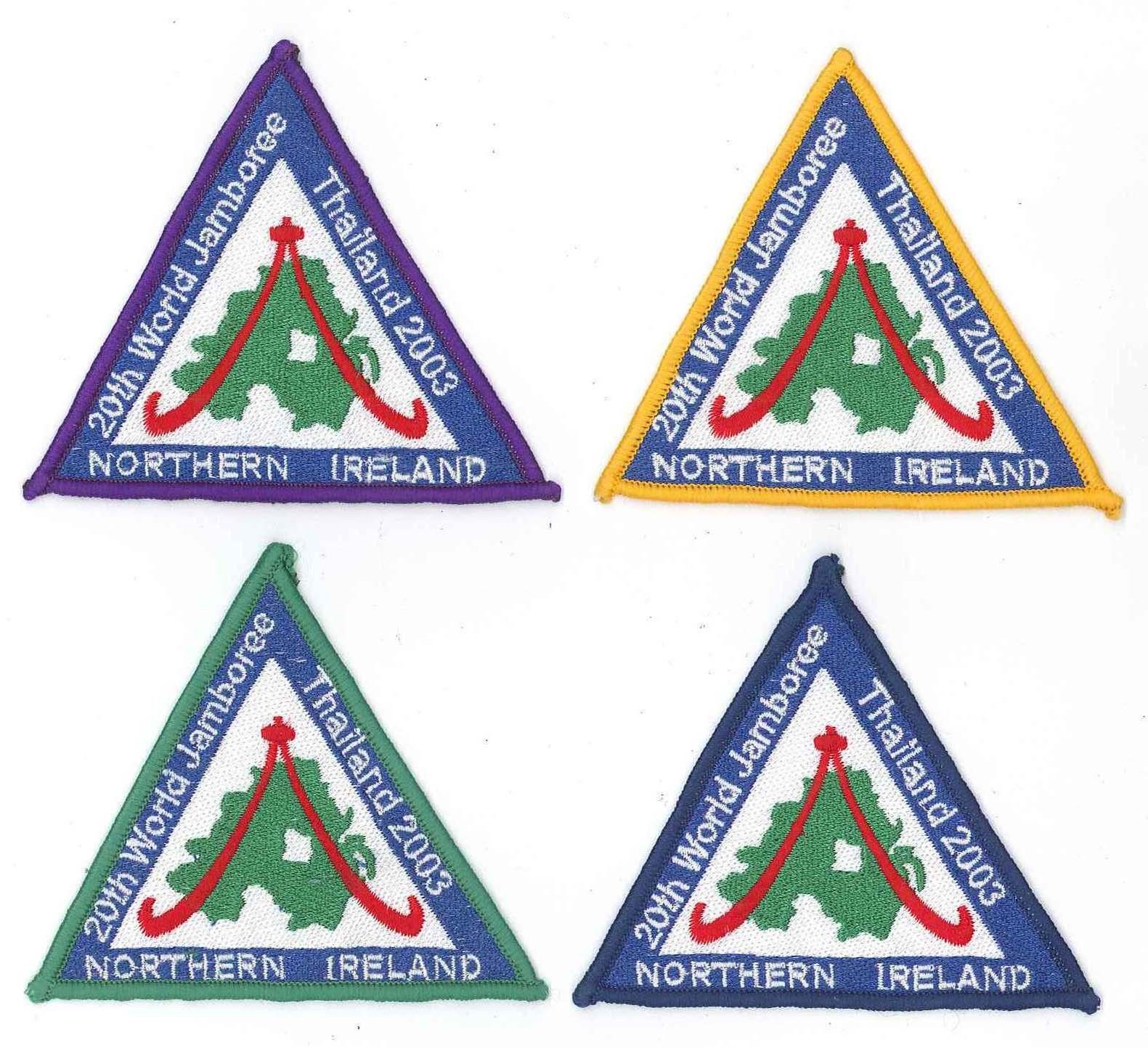
The 20th World Scout Jamboree took place from December 28th 2002 to January 8th 2003 in the naval base in Sattahip, Thailand. Around 40 Scouters from Northern Ireland took part.
21st World Jamboree United Kingdom 2007 |
| The event was held for 12 days between 27 July and 8 August, in Hylands Park, Chelmsford, Essex. The Irish contingent was made up of eight Scout Troops consisting of 32 scouts and 4 leaders in each Troop as well as 140 International Service Team members from Scouting Ireland. | 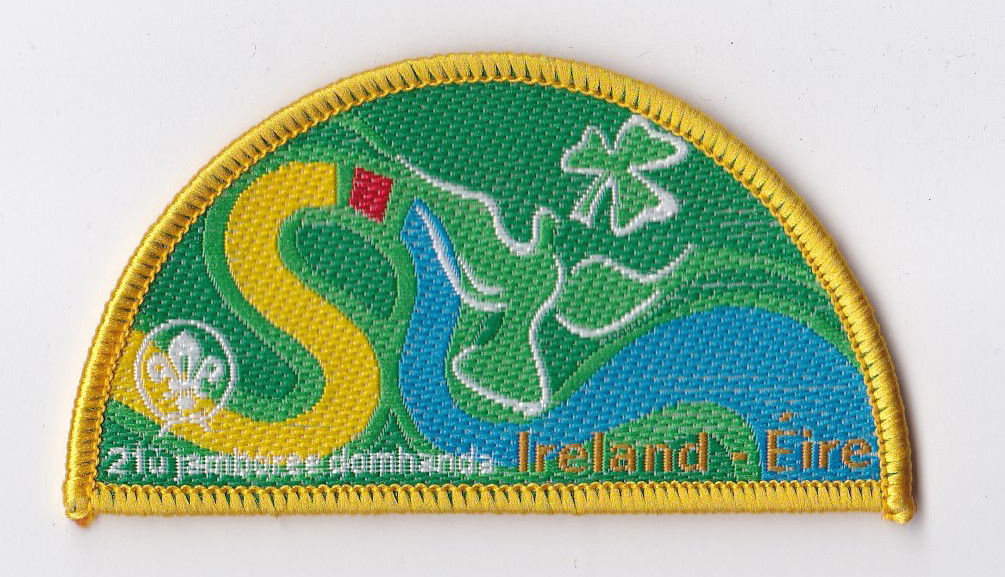 |
 | Maigue, The River flows through the village of Adare and, after many bends, joins the Shannon Estuary on its southern shore downstream (west) of Limerick. |
Dalua, the River Dalua is just over 15 miles long and is located mainly in County Cork, it flows into the River Blackwater. |  |
 | Eske, The River Eske also variant spelling Eask in Irish Abhainn na hIascaigh is a river in the northwest of Ireland in County Donegal in Ulster, beginning at Lough Eske in southeast County Donegal before flowing mainly westwards to the town of Donegal and into the Atlantic via Donegal Bay. |
Laune, the River Laune rises in Lough Leane, one of the Lakes of Killarney and flows down to Castlemaine Harbour and out into Dingle Bay, said to be one of the best rivers in Ireland for Salmon and Trout fishing. |   |
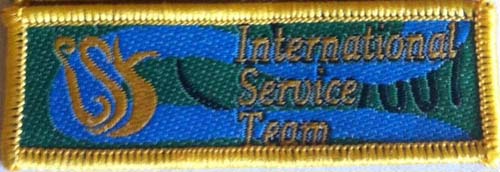 | Scouting Ireland also provided a large Service Team for the Jamboree. |
22nd World Jamboree Sweden 2011 |
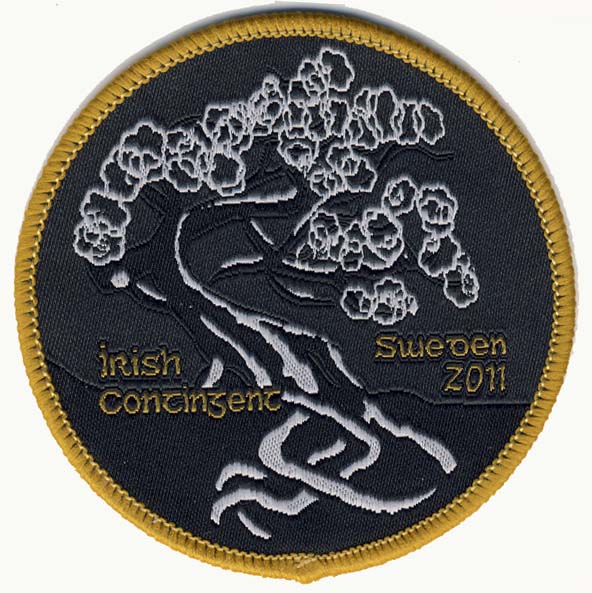
The 22nd World Scout Jamboree took place in Rinkaby, Kristianstad, Scania in southern Sweden from 27 July to 7 August 2011. The theme was Simply Scouting. 40,061 Scouts, leaders and adult volunteers participated from 166 different countries, 761 from Ireland. The sub-camp of the Irish team were named after Trees, the Tree names were in Gaelic on the badges.
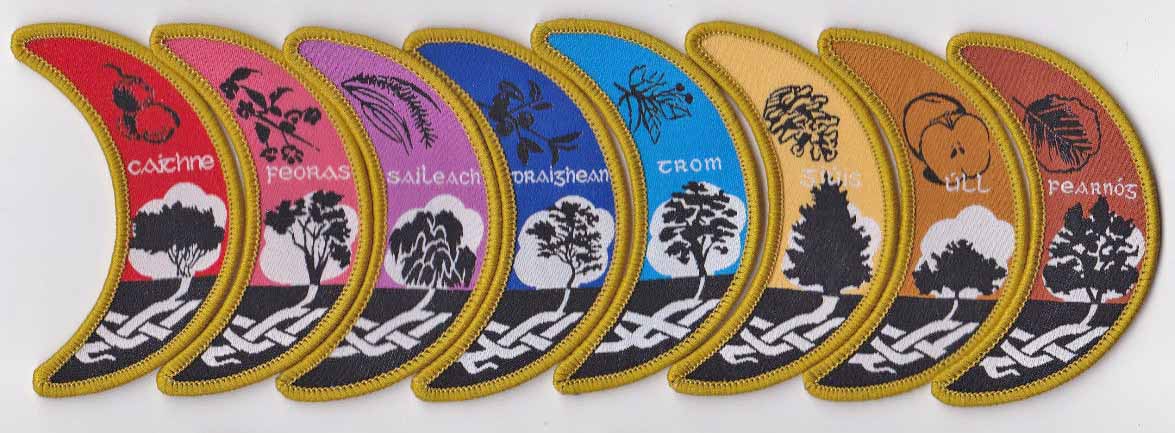
Caithne = Arbutus
Feoras = Spindle
Saileach = Willow
Draighean = Blackthorn
Trom = Elder
Tiuis = Douglas Fir
Úll = Apple
Fearnog = Alder

Caorthan(n) = Rowan or Mountain Ash for some reason it has only one n on the badge.
Beith = Birch
Silín = Cherry
Leamhán = Elm
Fuinseóg = Ash
Coll = Hazel
Iur = Yew
Cuileann = Holly
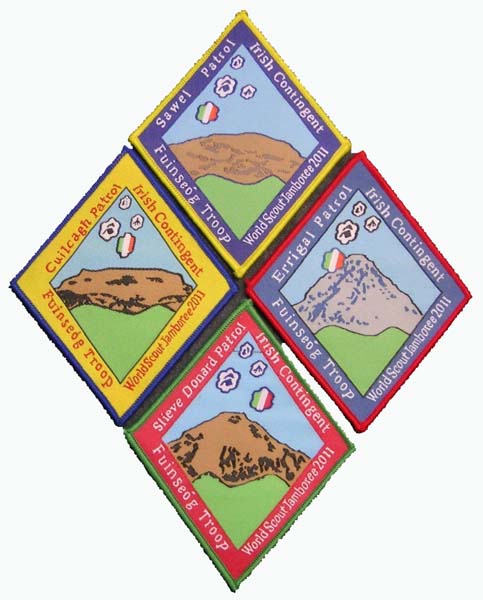
The above are the Ash Patrol’s badges, each patrol was named after an Irish mountain. The Jamboree was divided into sub-camps within the sub-camps each unit consisted of 4 patrols, a patrol consisted of 9 Scouts and 1 adult.
Fuinseóg = Ash (the tree not the remains of a fire)
Sawel Patrol = Sawel Mountain (from Irish: Samhail Phite Méabha, meaning "likeness to Meabh's vulva") is a mountain in County Londonderry and County Tyrone, Northern Ireland. It is the highest peak in the Sperrin Mountains, and the 8th highest in Northern Ireland.
Cuilcagh Patrol = Cuilcagh (Irish: Binn Chuilceach) is a mountain on the border between County Fermanagh in Northern Ireland and County Cavan in the Republic of Ireland once part of the medieval Kingdom of Breifne. With a height of 665 metres, 2,182 feet, it is the highest point in both counties and the 165th highest on the island of Ireland.
Errigal Patrol = Errigal Mountain (Irish: An Earagail, possibly meaning "oratory") is a 751-metre, 2,464 foot mountain near Gweedore in County Donegal, Ireland. It is the tallest peak of the Derryveagh Mountains, the tallest peak in County Donegal, and the 76th tallest peak in Ireland. Errigal is also the most southern, steepest and highest of the mountain chain, called the "Seven Sisters" by locals.
Slieve Donard Patrol = Slieve Donard (from Irish: Sliabh Dónairt, meaning "Dónairt's mountain") is an 850-metre 2,790 foot mountain in County Down, Northern Ireland. Part of the Mourne Mountains, it is the highest peak in Northern Ireland.
| There was also a Scarf/Necker issued for the Jamboree. | 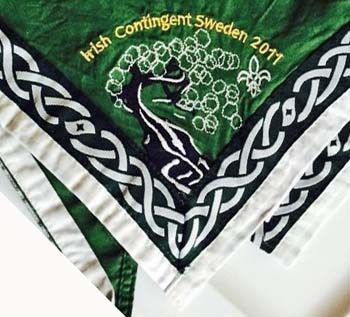 |
22nd World Scout Jamboree Japan 2015 |
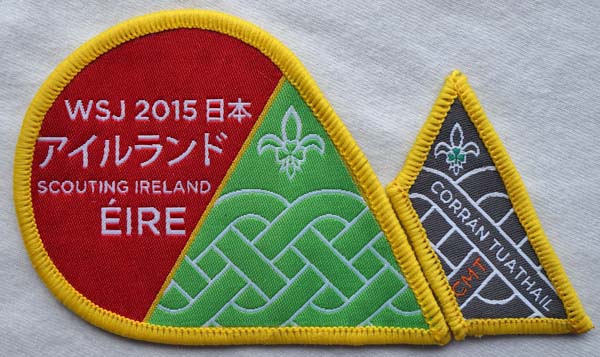
The Contingent Badge worn by all members of the Irish Contingent shows the rising sun over a mountain with a Celtic knot which intertwines with the Celtic Knot on the sub-camp badge.
Around 300 Irish Scouters attended the 23rd World Scout Jamboree made up of 6 troops of 36 Scouts and 4 leaders plus the Contingent Management Team C.M.T. and the International Service Team I.S.T. Each troop and the CMT and IST had a separate badge and each troop and both service teams were named after an Irish Mountain. The badges were designed by Matthew Foster from the 94th Dublin (Walkinstown) Scout Group.
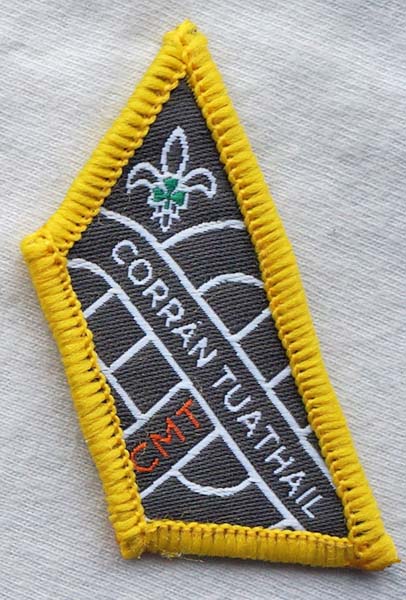 |
Contingent Management Team CMT. Worn by the Irish CMT. Corrán Tuathail (Carrauntoohil). It is the highest peak on the island of Ireland. Located in County Kerry it is 1,038 metres or 3,406 foot high. Carrauntoohil is classed as a Furth (a mountain more than 3000 foot high outside of Scotland) by the Scottish Mountaineering Club and is sometimes referred to as one of the Irish Munros. The official Irish name is Corrán Tuathail which has been interpreted as "inverted sickle" or "Tuathal's sickle", Tuathal being a male first name. One of the earliest mentions of the mountain, by Isaac Weld in 1812, refers to it as 'Gheraun-Tuel' which suggests that the first element was géarán "fang" which is found in the names of other Kerry mountains and that an earlier name may have been Géarán Tuathail "Tuathal's fang" |
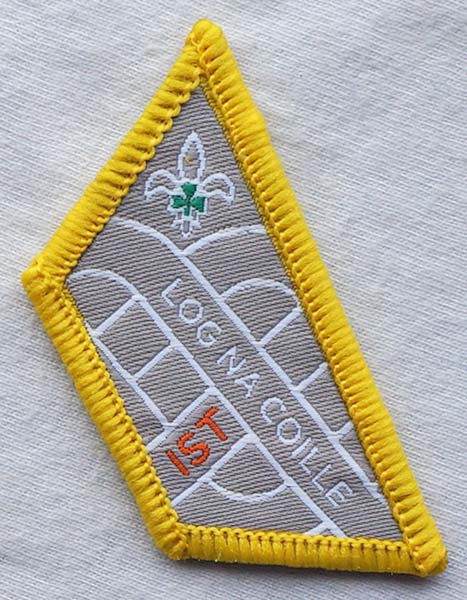 |
International Service Team (IST). Worn by Irish members of the IST. Log na Coille (Lugnaquilla) is a 925-metre 3,035 foot high mountain in County Wicklow, Ireland. Log na Coille translates as hollow of the wood. The mountain is the highest peak of the Wicklow Mountain range, the highest in the province of Leinster, and the 13th highest peak in all Ireland. As it is over 3000 foot high it is referred to as an Irish Munro and is classed as a Furth (a mountain more than 3000 foot high outside of Scotland) by the Scottish Mountaineering Club. Lugnaquilla is a bulky mountain, with a large plateau-type summit, bounded on two sides by steep glacial corries called "North Prison" and "South Prison." |
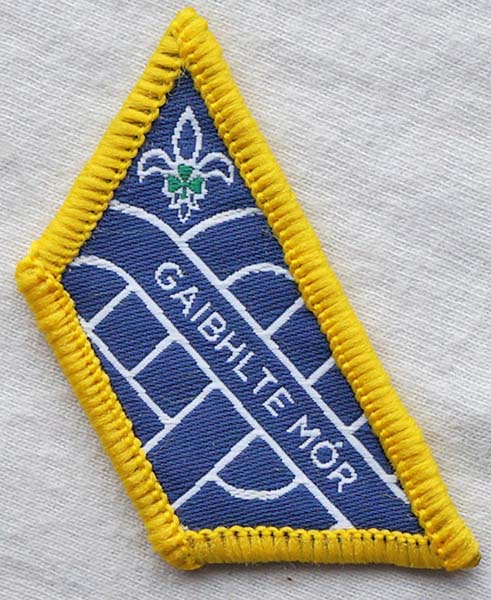 | Gaibhlte Mór (Galtymore) or Cnoc Mór na nGaibhlte, meaning "big hill of the Galtys" is a 919 meters or 3015 foot mountain on the border between counties Limerick and Tipperary. It is the highest of the Galty Mountains and the 14th highest peak in Ireland. Galtymore is notable in that it is the tallest inland mountain in Ireland, and the only inland peak to exceed 3000 feet. Referred to as an Irish Munro and is classed as a Furth (a mountain more than 3000 foot high outside of Scotland) by the Scottish Mountaineering Club. |
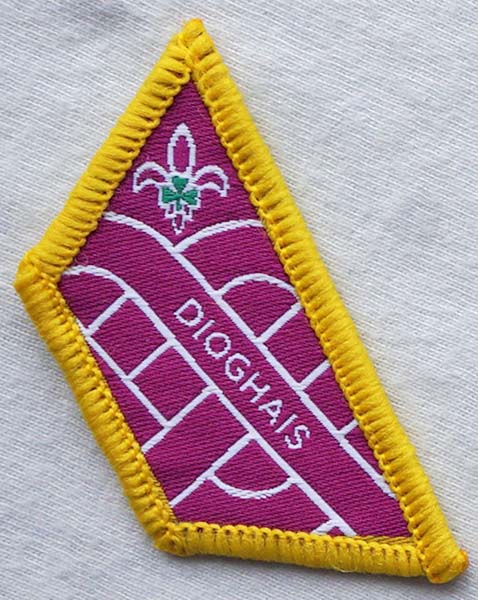 | Dioghais (Djouce) in English fortified height. Is situated in the north-eastern section of the Wicklow Mountains. The mountain is also known as Jason’s Bane. It is 725 meters or 2379 foot high. |
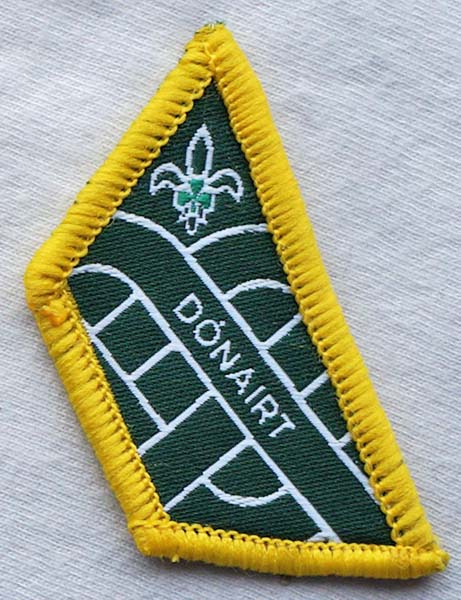 | Dónairt (Slieve Donard) in English Dónairt's Mountain. 850 Meters or 2790 foot high. Dónairt is in County Down Northern Ireland and is part of the Mourne Mountain range. It is the highest peak in Northern Ireland and in the province of Ulster. It is the 19th highest peak on the island of Ireland. |
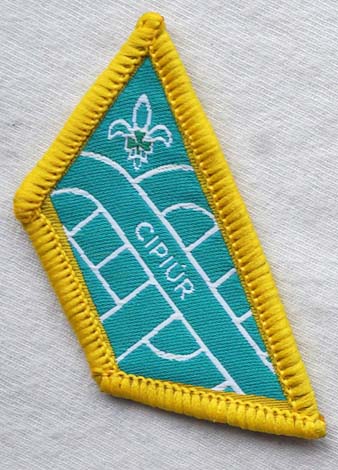 | Cipiúr (Kippure). 757 Meters or 2484 foot high it is the highest mountain in County Dublin and the 73rd highest mountain in Republic of Ireland. At the summit of Kippure is a 127 meter high television and radio transmitter mast, the oldest television transmitter site in the Republic of Ireland. |
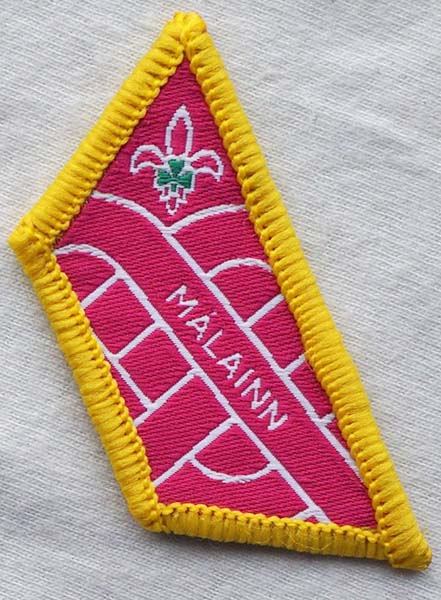 | Malainn (Maulin) meaning high or sloping ground is in the north eastern part of the Wicklow Mountains. Height 570 meters or 1870 foot. Good views of Djouce and Sugar Loaf mountains, the north face is covered with forest know as Crone Wood. |
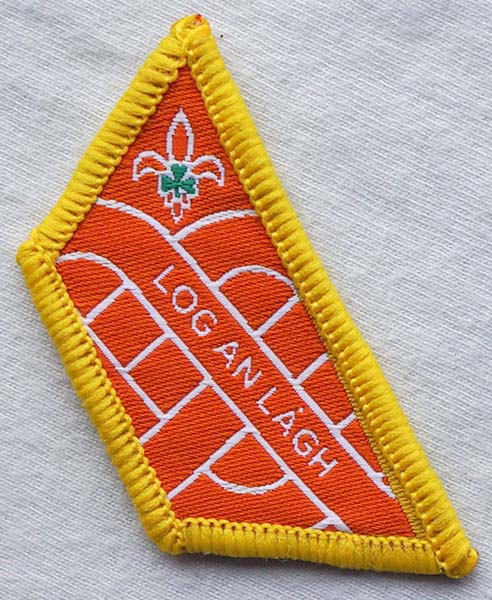 | Log an Lagh (Loughanleagh) County Cavan. 344 meters or 1119 foot high. Lough an Lea mountain derives its name from the Irish, "Loch an Leigheas" meaning 'lake of the cure', it was believed that the lake now gone due to land drainage had magical powers to bring soldiers killed in battle back to life. |

The Dónairt Troop had Patrol badges, not sure if these were official Jamboree badges but they were worn on the uniform by the Dónairt Troop.
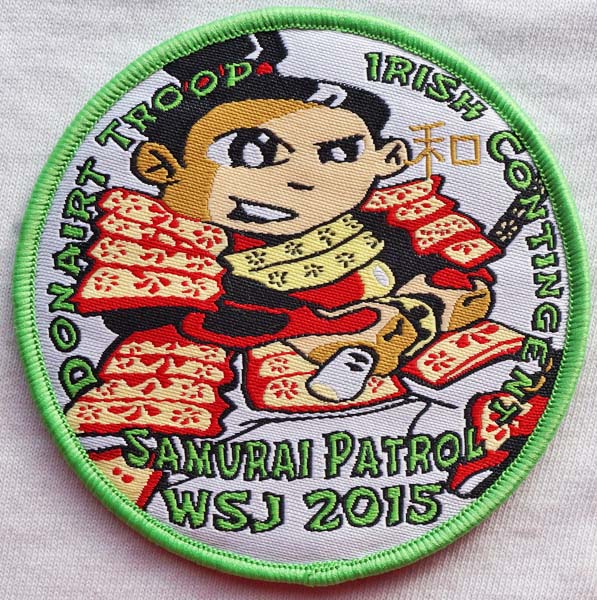 Samurai Patrol | 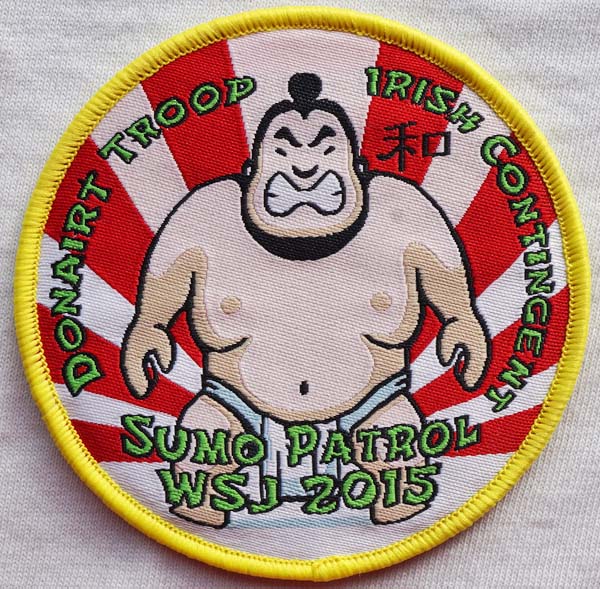 Sumo Patrol |
 Ninja Patrol | 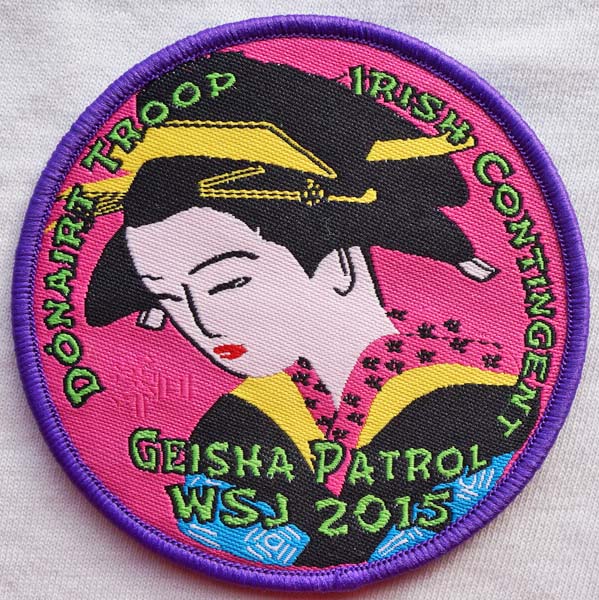 Geisha Patrol |
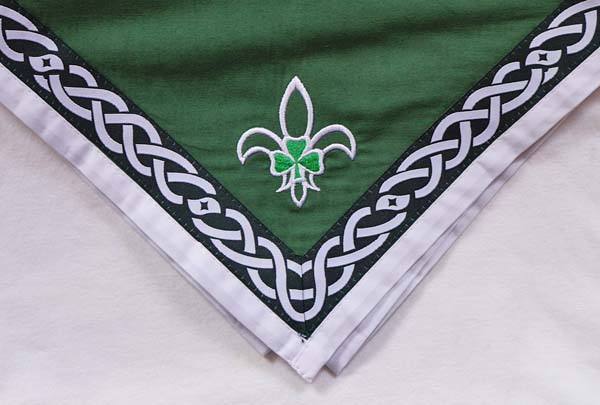 | 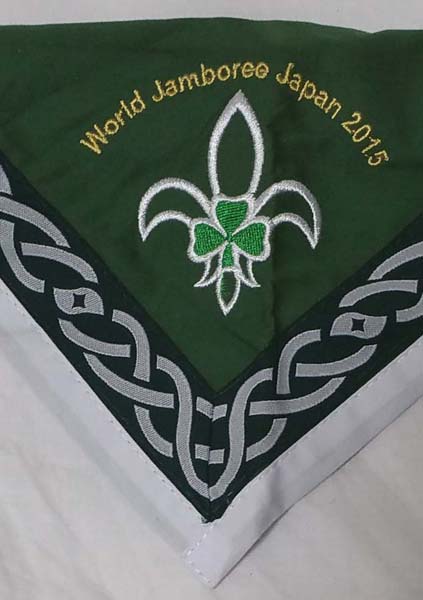 |
Scouting Ireland introduced a new design World Necker/Scarf after the Sweden Jamboree, similar to the design used in Sweden 2011 the new design had a larger Scouting Ireland logo and was designed to be worn at any international event, the name of the event could be added over the Scouting Ireland logo as with the 2015 Jamboree.
